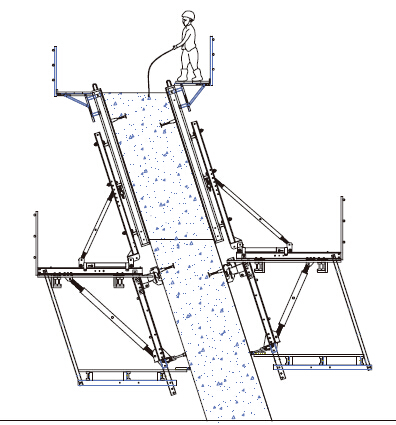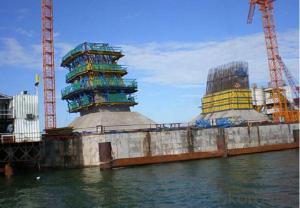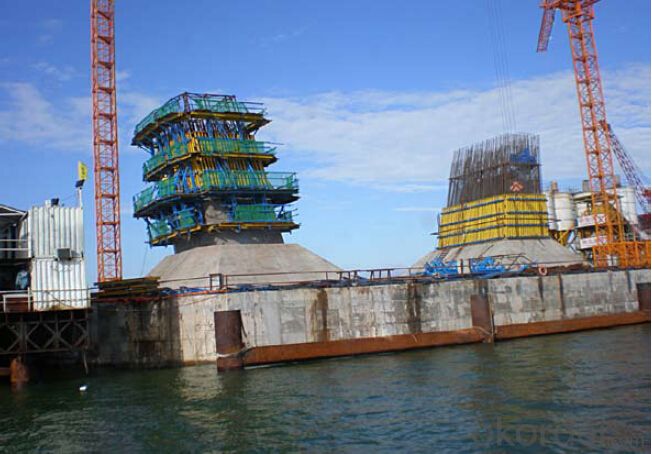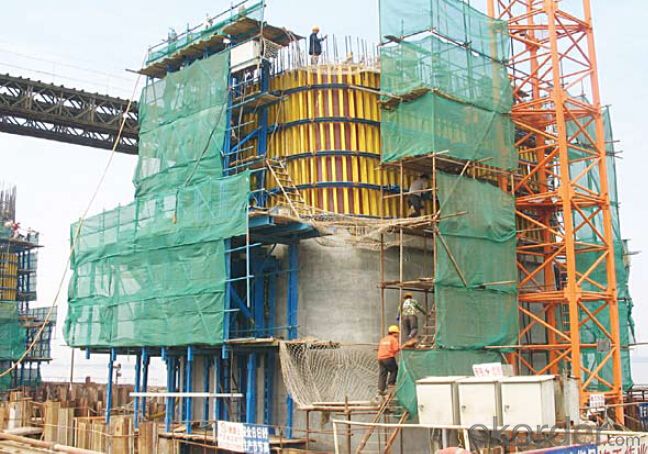Auto climbing bracket ACB-100 for formwork and scaffolding system
- Loading Port:
- Tianjin
- Payment Terms:
- TT OR LC
- Min Order Qty:
- 50 m²
- Supply Capability:
- 1000 m²/month
OKorder Service Pledge
OKorder Financial Service
You Might Also Like
Auto-climbing Bracket ACB100 & ACB50
The power of the auto-climbing formwork is the hydraulic system, which includes the oil cylinder
and two commutators. The commutators can control the climbing of climbing rail and the bracket.
The steel rail and the bracket can inter-climbing, so the whole system will climb up steadily.
Cranes are not needed during the construction. It’s easy to operate, highly efficient and safe. It’s
the best choice for the construction of high buildings and bridges.
There are mainly two types of standard auto-climbing brackets, ACB-50 and ACB-100, the figure
means the push power of cylinder with unit of KN.
Characteristics:
◆ Perfect load bearing anchor system
Anchor system is the most important supporting part. The system is made of five parts shown
below. Thereinto, tensile bolt, V-climbing cone and washer can be taken out for reusing after the
concrete pouring finished.There are two kinds of anchor systems,A & B. A is matched with single
anchor shoe and B is matched with double anchor shoe.
◆ Crane-independent
Crane-independent forming, striking and climbing speeds up the work procedures on the
construction site and also makes them independent of each other. This means the planned
sequences can be maintained along with guaranteeing high productivity levels. The crane can
therefore be used for other tasks.
Hydraulic system is mainly made of two commutators,
oil cylinder and power distribution system.The
commutators can control the climbing of climbing rail
and bracket.
◆ High bearing capacity and safe
The stable working platforms are able to carry large loads, e.g. the storage of reinforcing steel
for the next climbing section. Generously-sized working platforms, the well thought-out design for
handling very high wind loads and the patented control function of the climbing mechanism are
some of the special details contained within the comprehensive safety concept.
◆ Platforms adjusted to suit the angle of inclination
The horizontal working areas thus created provide safe and comfortable conditions for
reinforcement work, shuttering and striking, concreting and finishing.
◆ The ACB formwork system can climb not only vertically but also slantways, the largest angle is
18 degrees.
◆ The system can climb up wholly or separately. The climbing process is steady, synchronous
and safe.
◆ The bracket will not fall to the ground until the construction is finished, the field will be saved
and the impacting breakage will be reduced (especially the panel).
◆ The system will furnish omnidirectional platform, the construction organizations don’t need to
set up additional operation platform.
◆ The error of structure construction is small and easy to correct.
◆ The climbing speed is fast, the construction course will be quickened.
◆ The formwork can climb itself and cleaning work can be done in the same situs , the used times
of tower crane will be greatly reduced.

- Q: Can steel formwork be used for projects with stringent quality requirements?
- Yes, steel formwork can definitely be used for projects with stringent quality requirements. Steel formwork is known for its durability, strength, and consistency, making it an ideal choice for projects where precision, accuracy, and high-quality finishes are essential. Steel formwork is capable of withstanding heavy loads and can maintain its shape and dimensions over multiple uses, ensuring that the concrete structure is formed accurately and precisely according to the design specifications. Additionally, steel formwork provides a smooth surface finish, reducing the need for extensive post-construction finishing work. Its robustness and stability make it suitable for projects requiring stringent quality control, such as high-rise buildings, bridges, and infrastructure projects. Furthermore, steel formwork allows for easy customization, enabling contractors to meet specific project requirements efficiently. Overall, steel formwork is a reliable and efficient choice for projects with stringent quality requirements, ensuring that the final structure meets the highest standards of quality and durability.
- Q: Can steel formwork be used for both straight and curved concrete elements?
- Yes, steel formwork can be used for both straight and curved concrete elements. Steel formwork is highly versatile and can be easily adjusted and shaped to accommodate different design requirements. It offers excellent strength and durability, making it suitable for constructing both straight and curved concrete elements. The flexibility of steel formwork allows for the creation of complex and intricate shapes, making it ideal for projects that require curved elements such as architectural features, curved walls, or circular structures. Additionally, steel formwork provides a smooth and uniform surface finish, ensuring high-quality concrete results for both straight and curved elements.
- Q: Can steel formwork be used for both small and large-scale concrete placements?
- Steel formwork is versatile and can be employed for concrete placements of any size. With its robustness and endurance, steel formwork is ideal for a range of construction endeavors. Its assembly and disassembly are effortless, enabling cost-effective utilization in both minor and major concrete placements. Moreover, steel formwork imparts a uniform and sleek finish to the concrete surface, guaranteeing superior outcomes irrespective of the project's magnitude. Consequently, be it a petite residential construction or an expansive infrastructure venture, steel formwork proves to be a dependable option for concrete placements.
- Q: Is steel formwork more expensive than other types of formwork?
- Yes, steel formwork is generally more expensive than other types of formwork. Steel is a durable and strong material, making it a preferred choice for construction projects. However, its higher cost compared to alternatives such as wood or plastic formwork can be attributed to the higher manufacturing and material costs associated with steel.
- Q: Can steel formwork be used for precast concrete slabs with openings?
- Precast concrete slabs with openings can indeed utilize steel formwork. Renowned for its durability and strength, steel formwork proves suitable for intricate and elaborate designs, including slabs with openings. By employing steel formwork, construction becomes precise and accurate, as it ensures the desired dimensions and shape of the openings. Furthermore, the steel formwork can be effortlessly adjusted and modified to accommodate various sizes and shapes of openings, granting design flexibility. In addition, the reusability of steel formwork renders it a cost-effective option for precast concrete slabs with openings. However, it remains crucial to engineer and design the steel formwork adequately to withstand the weight and forces exerted by the concrete and the openings.
- Q: What are the considerations when designing steel formwork for retaining structures?
- When designing steel formwork for retaining structures, there are several important considerations that need to be taken into account. Firstly, the structural stability of the formwork needs to be ensured, as it will be subjected to significant loads and pressures from the weight of the concrete and the earth it is retaining. The formwork needs to be designed to withstand these loads without deformation or failure. Additionally, the formwork should be easy to assemble, disassemble, and adjust. This is important for efficiency during construction and for future maintenance or repairs if needed. The design should allow for quick and easy installation of the formwork system. Another consideration is the durability of the formwork. Steel formwork should be resistant to corrosion, as it will be exposed to moisture from the concrete. Proper surface treatment and protective coatings should be applied to ensure its longevity. Furthermore, the formwork should be designed to provide a smooth and consistent finish to the concrete. This is important for the aesthetic appearance of the retaining structure and for ensuring the desired structural integrity. Lastly, cost-effectiveness is an important consideration. The design of the steel formwork should aim to minimize material usage and labor costs, while still meeting the required performance and safety standards. Overall, when designing steel formwork for retaining structures, the considerations include structural stability, ease of assembly and adjustment, durability, concrete finish quality, and cost-effectiveness.
- Q: How does steel formwork affect the overall stability of a structure?
- The overall stability of a structure is greatly influenced by steel formwork. Formwork, which is temporary molds or frameworks used to shape and support wet concrete until it becomes self-supporting, plays a vital role. Steel formwork offers numerous advantages that positively impact the stability and strength of the structure. To begin with, steel formwork possesses exceptional strength and durability compared to materials like wood or plastic. This high strength enables steel formwork to withstand the pressure from wet concrete without deforming or collapsing. As a result, the stability of the structure is enhanced because the formwork maintains its shape and rigidity during the concrete pouring and curing process. Furthermore, steel formwork provides better dimensional accuracy and consistency. Its rigid nature prevents any movement or shifting, ensuring that the concrete is poured and cured in the desired shape and dimensions. This precise accuracy is crucial for maintaining the structural integrity and stability of the final construction. Moreover, steel formwork allows for greater design and construction flexibility. It can be easily customized and shaped to meet the specific requirements of the structure, allowing architects and engineers to create intricate and unique designs. This flexibility enhances the overall stability of the structure by enabling efficient load distribution and reinforcement placement. Additionally, steel formwork exhibits excellent load-bearing capacity. It efficiently distributes the weight of the wet concrete, as well as any additional loads imposed during construction such as workers, equipment, or construction materials. This load-bearing capacity ensures that the structure remains stable and can withstand the imposed loads without compromising its integrity. Lastly, steel formwork has a longer lifespan compared to other formwork materials. Its durability and resistance to deterioration increase the overall stability of the structure over time. Steel formwork can be reused multiple times, reducing waste and costs while maintaining the desired stability and quality of the finished construction. In conclusion, steel formwork plays a significant role in enhancing the overall stability of a structure. Its strength, dimensional accuracy, flexibility, load-bearing capacity, and longevity ensure that the formwork maintains its shape and rigidity, supporting the wet concrete and allowing it to cure properly. By providing a solid and reliable foundation, steel formwork enhances the stability and strength of the structure, ensuring its long-term durability.
- Q: How does steel formwork handle reinforcement placement?
- Steel formwork is a versatile and popular option in construction because of its strength, durability, and efficient reinforcement placement. When it comes to handling reinforcement placement, steel formwork offers multiple advantages. To begin with, steel formwork provides a sturdy structure that can withstand the weight and pressure of reinforcement bars. This ensures that the bars remain in their desired position during the concrete pouring process, eliminating the risk of deformation or displacement. Consequently, the structural integrity of the final concrete structure is ensured. Moreover, steel formwork comes with pre-determined holes and slots, enabling precise placement of reinforcement bars. These pre-designed openings allow for quick and accurate installation of the bars, reducing the time and effort required for reinforcement placement. Additionally, steel formwork offers the flexibility to adjust the position of the reinforcement bars if necessary, ensuring optimal placement for specific project requirements. Furthermore, steel formwork provides easy access to the reinforcement bars during concrete pouring. Removable panels or openings can be incorporated into the formwork design, allowing construction workers to monitor and adjust the placement of reinforcement bars as needed. This accessibility guarantees proper positioning of the reinforcement, preventing any potential weak areas or structural deficiencies in the concrete structure. Lastly, steel formwork allows for efficient integration of various reinforcement elements, such as steel mesh, rebar cages, or post-tensioning systems. The formwork system can be designed to accommodate these different reinforcement methods, ensuring compatibility and ease of installation. This flexibility in reinforcement placement is particularly advantageous for complex or intricate concrete structures that require specific reinforcement configurations. In conclusion, steel formwork is well-suited to handle reinforcement placement efficiently. Its strength, rigidity, and pre-designed openings enable accurate and secure positioning of reinforcement bars. The accessibility and adaptability of steel formwork further enhance its capability to handle various reinforcement elements, ensuring the integrity and strength of the final concrete structure.
- Q: What are the different types of release agents used with steel formwork?
- There are several different types of release agents that can be used with steel formwork. Some of the most common types include: 1. Water-based release agents: These types of release agents are composed primarily of water, with additives such as surfactants and lubricants. They are environmentally friendly and easy to apply, typically by spraying or brushing onto the steel formwork. Water-based release agents form a thin film on the surface of the steel, preventing adhesion of the concrete during the curing process. 2. Solvent-based release agents: Solvent-based release agents use organic solvents as the carrier for the active ingredients. They are effective in providing a smooth surface finish on the concrete and are often used in situations where a higher level of release performance is required. Solvent-based release agents are typically applied by spraying or brushing and evaporate quickly, leaving a thin film on the steel formwork. 3. Barrier release agents: Barrier release agents are typically applied as a thick paste or gel and provide a physical barrier between the steel formwork and the concrete. They are often used in situations where a high-quality surface finish is required, such as architectural concrete applications. Barrier release agents can be applied by brushing or troweling onto the steel formwork. 4. Dry release agents: Dry release agents are powdered or granular materials that are applied directly to the steel formwork. They create a non-stick surface by absorbing excess moisture from the concrete, preventing adhesion. Dry release agents are commonly used in situations where other types of release agents may not be suitable, such as in cold weather conditions. 5. Form release oils: Form release oils are petroleum-based products that are commonly used with steel formwork. They provide an effective release barrier between the steel and the concrete, preventing adhesion. Form release oils are typically applied by spraying or brushing onto the steel formwork and can be used in a variety of concrete applications. It is important to select the appropriate type of release agent based on the specific requirements of the project, including the desired surface finish, environmental considerations, and ease of application. Consulting with a professional or manufacturer's recommendations can help determine the most suitable release agent for a particular steel formwork application.
- Q: What are the common safety precautions when working with steel formwork in extreme temperatures?
- When working with steel formwork in extreme temperatures, it becomes imperative to implement specific safety measures in order to safeguard the workers' well-being and successfully complete the project. Consider the following essential safety precautions: 1. Adequate Personal Protective Equipment (PPE): Workers must wear suitable PPE, including heat-resistant attire, gloves, and safety goggles, to shield themselves from extreme temperatures and potential hazards. 2. Regular hydration: It is crucial to ensure that workers stay hydrated when faced with extreme temperatures. Encourage frequent breaks for water consumption and provide access to cool drinking water on-site. 3. Provision of shaded and rest areas: Establish shaded spaces or rest zones where workers can take breaks and escape direct exposure to heat. This will help prevent heat-related illnesses such as heat exhaustion or heat stroke. 4. Training and awareness: Guarantee that all workers receive proper training and education regarding the potential risks associated with working in extreme temperatures. They should be knowledgeable about the signs of heat-related illnesses and be prepared to respond in emergency situations. 5. Monitoring weather conditions: Regularly check weather forecasts and stay informed about extreme temperature warnings or heat advisories. If possible, adjust work schedules to minimize exposure to extreme heat. 6. Implementation of a buddy system: Establish a buddy system where workers can watch out for each other. This ensures that any heat-related issues can be promptly identified and addressed. 7. Regular breaks and scheduling: Plan work schedules in a manner that allows for frequent breaks and rest periods. This helps prevent overexertion and reduces the risk of heat-related illnesses. 8. Proper ventilation: Ensure that the work area is adequately ventilated to facilitate air circulation and minimize heat accumulation. This can be achieved through the use of fans or natural ventilation methods. 9. Regular communication: Maintain open lines of communication with workers to monitor their well-being and address any concerns they may have regarding working in extreme temperatures. 10. Emergency response: Establish a well-defined emergency response plan that includes procedures for handling heat-related emergencies. This should encompass providing first aid, accessing medical assistance, and evacuating the work area if necessary. By adhering to these common safety precautions, workers can mitigate the risks associated with working in extreme temperatures while utilizing steel formwork, thereby ensuring a safe and productive work environment.
Send your message to us
Auto climbing bracket ACB-100 for formwork and scaffolding system
- Loading Port:
- Tianjin
- Payment Terms:
- TT OR LC
- Min Order Qty:
- 50 m²
- Supply Capability:
- 1000 m²/month
OKorder Service Pledge
OKorder Financial Service
Similar products
Hot products
Hot Searches



















